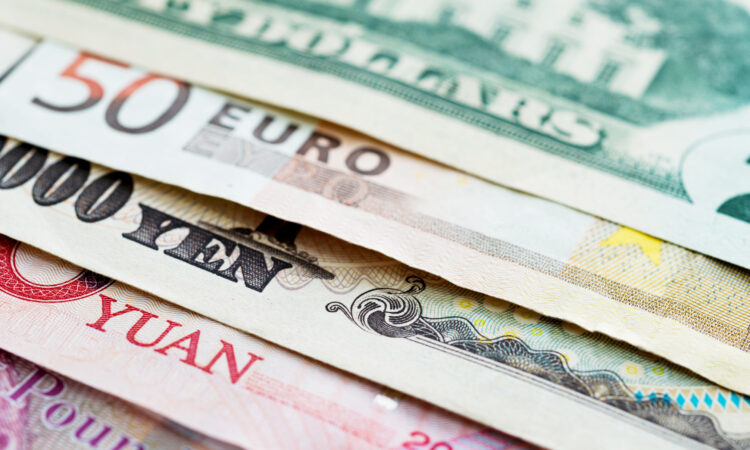
May 21, 2024
The Euro’s share of international transactions is likely smaller than it looks
Analysts have relied on monthly reports about the relative shares of the world’s currencies in international payment transactions, released by the Society for Worldwide Interbank Financial Telecommunication (SWIFT), to assess the importance of various currencies in the global payment system. The latest SWIFT report shows that, in March 2024, the dollar improved its position, accounting for 47.37 percent of the total transaction value of all messaging, while the Euro declined to an all-time low of 21.93 percent. By comparison, the RMB remained in the fourth position with 4.69 percent of all transactions, having moved from the fifth position six months ago. It is still behind the British pound GBP at 6.57 percent but ahead of the yen JPY at 4.13 percent.
While the SWIFT report confirms the preeminent position of the dollar in the global payment system, it has over-reported the relative share of the Euro and under-estimated that of the RMB—basically due to the design (measuring trades between nations regardless of whether some belong to a monetary union) and coverage (only counting transactions within SWIFT) of its reporting system.
Over-reporting the Euro’s share
Regarding the use of the Euro in international payments, a recent analysis by the European Central Bank (ECB) shows that most Euro transactions (57 percent of the total) take place between banks situated within the Euro Area (EA)—where the Euro should be considered a domestic currency by virtue of the European Monetary Union. Truly international transactions using the Euro—where at least one initiating or receiving bank is located outside of the EA—account for only 43 percent of total Euro transactions. Consequently, excluding Euro transactions within the EA, the share of the Euro in truly international transactions is only 9.4 percent (equal to 43 percent of the 21.93 percent share reported by SWIFT). This puts the Euro on top of a group of secondary currencies including the GBP, RMB, the yen, CAD, SFR etc., but not as a peer in a position to compete against the dollar.
The relative shares of Euro transactions within and without the EA are not quite in line with those of intra- and extra-EA trades—accounting for 47 percent and 53 percent, respectively, of the combined trades of EA countries. However, as the EA trades a lot with the rest of the European Union (EU) thanks to the Single Market, intra-EU trade accounts for about 60 percent of total EU trade. As a measure of the EA and EU trade with the rest of the world, instead of the ratio of trade/GDP of 103 percent (for the EA) and 106 percent (for the EU), the true ratio of extra-EA trade/GDP is around 55 percent, and extra-EU trade/GDP around 42 percent—still ahead of the United States at 27 percent and China at 38 percent. However, the gap is less pronounced than thought.
The relatively modest position of the Euro in international payments, after a quarter century in operation and backed by the EA economy accounting for 12 percent of the global economy relative to the United States at 15.5 percent (both on a PPP basis) as well as an open capital account and pretty sophisticated financial markets with well-developed regulations reflects the unique strength of the dollar.
Underestimating the international use of the RMB
Against this backdrop, China appears to have embarked on a different path in promoting the international use of the RMB, taking advantage of the desire of many countries to reduce their reliance on the dollar which has been increasingly used by the United States in financial sanctions to promote its strategic goals. The challenges facing the Euro would be even more formidable in the case of the RMB. For various reasons, China wants to keep control of capital account transactions, making it difficult for the RMB to be freely transferable. Its financial markets are still not well developed and regulated in a transparent and predictable way.
Instead of trying to tackle these problems, China has leveraged its strength as the top partner to most countries in the world in trade and investment transactions, to promote the use of local currencies in settling those transactions, mostly on a bilateral basis. China has fostered this payment mechanism by signing bilateral currency swap lines with forty-four countries worth more than $500 billion to help provide each other’s currencies to importers, exporters as well as investors in both countries. It has developed a modern RTGS for high-value domestic payments using the China National Advanced Payment System (CNAPS), and for international payments using China Cross-border Interbank Payment System (CIPS)—using both to facilitate the clearing and settlement of RMB transactions outside of China. It has also made much progress in developing its Central Bank Digital Currency (CBDC)—called eCNY—for domestic and cross-border payments.
As a result of those efforts, China has been able to settle about 53 percent of its cross-border trade and investment transactions in RMB, while the dollar’s share has dropped to 43 percent from 83 percent in 2010. More generally, in a recent study, the IMF found that in a sample of 125 countries, the median usage of RMB in cross-border payments with China has increased from 0 percent in 2014 to 20 percent in 2021. In a recent update, the IMF reported that the yuan’s share of all cross-border transactions between Chinese non-banks with foreign counterparts has risen from close to zero fifteen years ago to 50 percent in late 2023, while the dollar has fallen from around 80 percent to 50 percent. In particular, during his recent visit to China, Russian President Vladimir Putin again confirmed that 90 percent of Russia-China trade (reaching a record $240 billion in 2023) has been settled in ruble and RMB. Uses of the RMB in cross-border payment, mainly in a bilateral setting, will likely grow in the future, reflecting the huge footprint of China in world trade and investment flows. These transactions are outside the SWIFT framework—by design, so as to avoid vulnerability to Western financial sanctions—so SWIFT data will under-estimate the true international use of the RMB in cross-border payments. And the under-estimation will get worse as uses of local currencies—of which the RMB usually takes one side of bilateral transactions—grow in future.
Furthermore, a portion of international RMB payments has gone through CIPS directly instead of using SWIFT messaging—CIPS can accommodate both forms of communication. According to a 2022 Bank of France report, about 80 percent of RMB payments use SWIFT messaging as many non-Chinese institutions have yet to install translators for CIPS messaging. Presumably, as CIPS has grown in membership and volume of transactions (having increased by 24 percent in 2023 over the previous year to an average daily volume of 482 billion yuan or $67 billion), it seems reasonable to expect that more institutions would have installed translators to participate fully in the CIPS network as they handle more RMB transactions. In any event, the portion of RMB payments going directly through CIPS will not be captured in SWIFT data, giving rise to another instance of under-estimation of the RMB share in international payments.
Conclusions
The global payment landscape is fragmenting. On a multilateral basis, the dollar is entrenched as the premier currency in payment transactions. However, several secondary currencies, of which the Euro is in the lead, and including the RMB, are being used for up to half of total international payments. Besides that, a growing number of cross-border payment arrangements using local currencies mostly on a bilateral basis has further fragmented the global payment system. Given China’s huge footprint in world trade and investment activities, the RMB will feature prominently in these bilateral cross-border payments. Such a fragmented payment system, especially growing uses of local currencies, entails a loss of efficiency compared to the use of a common means of payment in international transactions. However, the revealed preference of many countries seems to be an acceptance of efficiency loss in search for less vulnerability to US and Western financial sanctions in times of heightened geopolitical tension.
Hung Tran is a nonresident senior fellow at the Atlantic Council GeoEconomics Center, a former executive managing director at the Institute of International Finance and former deputy director at the International Monetary Fund.
Further reading
Image: Background of international currency notes.


